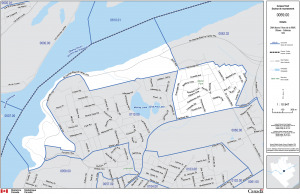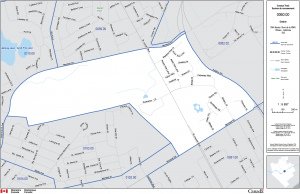Who lives in Manor Park? A duty to know; a duty to act [published May 2019 in the Manor Park Chronicle]
By Sébastien LaRochelle-Côté and Martha Patterson
Daniel Patrick Moynihan, the former U.S. Senator for New York, once said that “everyone is entitled to his own opinion, but not to his own facts”. For many in the neighbourhood, Manor Park is thought of as a quaint and comfortable neighbourhood, populated for the most part by affluent (and primarily English-speaking) families. But is it really the case? Do the statistical facts line up with this widely-held view of our neighbourhood?
Recently, numbers from the 2016 Census became available for two census tracts, or neighbourhoods, that roughly correspond to the boundaries of Manor Park. Census tracts do not always correspond to community boundaries, but it is the case with Manor Park.
The first neighbourhood, which we are calling Manor Park North in this article, is delimited by Birch Ave., Sandridge Rd., the Aviation Parkway and Hemlock Rd. (see Map 1). The other neighbourhood – let us call this one Manor Park South – includes the community of Cardinal Glen, which is also officially part of Manor Park but has its own community association with which MPCA is collaborating closely, as well as the portion of Manor Park that is located south of Hemlock, between Notre-Dame Cemetery, the Aviation Parkway, and Montreal Rd. (see Map 2). Manor Park North is sometimes referred to as Manor Park West, and Manor Park South is sometimes referred to as Manor Park East.
The results of the Census will likely surprise many. Did you know, for instance, that in Manor Park South (population: 4,341 in 2016), as many as 42% of residents reported French as their first official language spoken? In Manor Park North (population: 3,375 in 2016), 21% reported French as their first official language. This is compared with 15% for the City of Ottawa as a whole.
You may also be surprised to learn that Manor Park has a very diverse population. In both Manor Park South and North, immigrants accounted for about one quarter of the total population (a proportion similar to that of Ottawa), and approximately one-half came to Canada during the 2000s. In Manor Park North, many immigrants (about one in six!) listed the Philippines as their country of birth. In Manor Park South, immigrants were born in a vast array of places including the Caribbean, African, and Asian countries.
All kinds of families are represented in Manor Park. Manor Park South, in particular, has a large population of seniors, with one third of residents aged 65 and older in 2016 (compared with 12% in Manor Park North). This is not a surprise given that the area is characterized by large apartment buildings that can accommodate smaller families and older residents. In Manor Park South, solo-dwellers accounted for more than half of all households! Single-parent families are also very present in the neighbourhood, accounting for one quarter of families in Manor Park South, and one fifth in Manor Park North.
Recent immigrants, single-parent families, and people living alone are commonly in lower income brackets, so another key statistic is the proportion of people who are living in low-income families in Manor Park. There are various ways to define low income. Here we will look at the “low-income cut-off” (LICO), a widely-used indicator that is the most similar to Canada’s official poverty line (but not available in the Census data). Families with an annual income below the LICO are said to be living in low income.
In Manor Park North, the prevalence of low income by this measure was 10%, comparable to the rate for the City of Ottawa. In Manor Park South, however, that same figure was over 22%. Even more sobering is the figure for children aged 0 to 17 in Manor Park South: nearly one third (31%) lived in families with incomes below the poverty line – two and a half times the rate for the city as a whole (12%). Among children aged 0 to 5 in Manor Park South, the rate was a staggering 37%.
One possible reason for living on a lower income is difficulty in finding work. In Manor Park South, the unemployment rate at the time of Census was 9.5%, compared with 8.4% in Manor Park North, and 7.2% for the City of Ottawa. Unemployment is often concentrated among those who have fewer education credentials and those who are more vulnerable – such as recent immigrants, people with disabilities, and single-parent families.
Clearly, Manor Park is very heterogeneous. It has a lot of diversity and different groups face different types of challenges in the northern and southern portions of the neighbourhood. Why is this important? Because it can help our community associations and other social non-profit organizations deliver better services to our community. It may also encourage Manor Parkers to mobilize in order to help those in our midst who may need additional support from the rest of us. We have a duty to know, but also a duty to act. After all, 100% of us are Manor Parkers!







